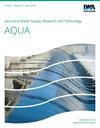结合压力残差矢量法和熵的概念设计配水系统的泄漏检测压力表网络
IF 4.3
Q2 Environmental Science
引用次数: 0
摘要
本文提出了一种利用压力残差矢量法中的熵概念设计配水系统压力表网络的算法。首先,通过39台自动机电水表实时采集用水信息,确定用水量的时间格局;在1年的观测过程中,计算对数正态概率密度函数的逐时统计参数。在此基础上,通过对各管道施加综合泄漏,确定各节点水头变化的平均熵,并进行组合优化,提出了水闸系统中的压力表网络。在不同泄漏参数(压力指数为0.5、1.0和1.5,发射器系数为0 ~ 0.8 m3/s)下,对规则和不规则WDS设计PGN的过程进行了测试。我们观察到,在足够的压力表数量后,熵含量并没有显著增加,这可以认为是PGN中所需的压力表数量。获得水头70%的熵值所需的监测时间约为40 h,而获得80%的熵值需要增加80 h的监测时间,严重影响了方法的效率。本文章由计算机程序翻译,如有差异,请以英文原文为准。
Pressure gauge network design for leakage detection in water distribution systems using a combination of the pressure residual vector method and the entropy concept
The present study proposed an algorithm to design a pressure gauge network in a water distribution system by employing the entropy concept in the pressure residual vector method. Firstly, the temporal pattern of water consumption was determined by collecting real-time information through 39 automatic electromechanical water meters. The observational process was performed over 1 year, and hourly statistical parameters were calculated for the log-normal probability density function. Afterwards, imposing the synthetic leakage in each pipe, determining the average entropy of water head variations in the nodes, and performing a combinatorial optimization process, a pressure gauge network (PGN) in a WDS was suggested. The proposed procedure of designing a PGN was tested for both regular and irregular WDS at different leakage parameters (pressure exponents 0.5, 1.0, and 1.5, and emitter coefficient between 0 and 0.8 m3/s). It was observed that the entropy content does not increase significantly after a convincing number of pressure gauges, which can be considered the required number of pressure gauges in the PGN. Furthermore, the monitoring time required to obtain 70% of the entropy content of the water head was about 40 h. However, the time to get 80% of the entropy content had to increase by 80 h, which severely impairs the method's efficiency.
求助全文
通过发布文献求助,成功后即可免费获取论文全文。
去求助
来源期刊
CiteScore
4.70
自引率
0.00%
发文量
74
审稿时长
4.5 months
期刊介绍:
Journal of Water Supply: Research and Technology - Aqua publishes peer-reviewed scientific & technical, review, and practical/ operational papers dealing with research and development in water supply technology and management, including economics, training and public relations on a national and international level.

 求助内容:
求助内容: 应助结果提醒方式:
应助结果提醒方式:


